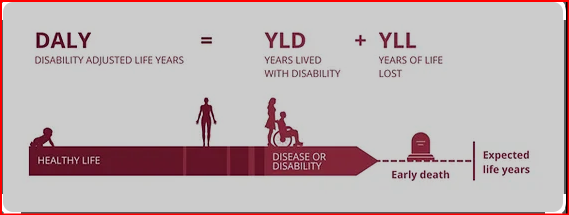The intersection of health and economics is critical, especially when addressing global health crises like HIV/AIDS. Effective allocation of resources demands rigorous evaluation of project feasibility. This article revisits health economics principles to assess a hypothetical HIV/AIDS project, focusing on cost-benefit analysis and the challenges of measuring impact. We’ll explore the concept of Disability-Adjusted Life Years (DALYs) averted as a key metric, and discuss the assumptions and data required to determine project viability.
The article will cover the cost-benefit ratio, the DALYs averted, the monetary value of the condoms supplied by the project and the investment required to achieve similar benefits in comparable interventions. Join us as we delve into the economics behind HIV/AIDS interventions, offering insights for policymakers, healthcare professionals, and anyone interested in maximizing the impact of health investments.
Project Overview and Resource Allocation
Imagine a multi-donor trust fund allocates $11.6 million to a comprehensive HIV/AIDS project. This project aims to strengthen the capacity of a national AIDS commission, increase community access to services, and promote behavioral change. Evaluating the economic feasibility of such projects is vital to ensure resources are used efficiently and effectively. The challenge lies in accurately measuring the benefits and converting them into monetary value. We adopt the common method of estimating disability-adjusted life years (DALYs) averted to address this.
Understanding Disability-Adjusted Life Years (DALYs)
The DALY concept extends potential years of life lost due to premature death (PYLL) to include equivalent years of healthy life lost due to states other than good health. Murray and Lopez (1996) define total DALYs as the sum of premature mortality (YLL) and non-fatal burden (YLD). This approach provides a comprehensive measure of disease burden, allowing for a more nuanced evaluation of health interventions. Using DALYs, we can better assess the true impact of HIV/AIDS projects on population health and well-being.
DALYs are calculated using the following formula:
YLL = N * C * e^(-r*a) * B
YLD = I * DW * L * K
Where:
- N = Number of deaths
- C = Age-weighting correction constant
- r = Discount rate
- B = Parameter from the age weighting function
- a = Age of onset
- L = Duration of disability or time lost due to premature mortality
- I = Number of incident cases in the reference year
- DW = Disability weight
- K = Parameter specifying whether age-weighting is specified (K=1) or not specified (K=0)
Key Assumptions in DALYs Averted Analysis
Several assumptions are crucial when analyzing DALYs averted. We assume a discount rate of 0.03, an age-weighting correction constant of 0.1658, and a parameter from the age-weighting function of 0.04, all based on Global Burden of Disease values. Additionally, the financial discount rate is set at 15%. These assumptions provide a standardized framework for evaluating the project’s impact. We also assume that reaching key populations through HIV/AIDS prevention and care will reduce the HIV/AIDS prevalence rate from 16% to 2%, a significant reduction that underscores the potential impact of effective interventions.
We also use unit costs of key interventions from previous studies, including prevention of mother-to-child transmission ($7.8 per pregnant woman counseled and tested), antiretroviral therapy ($459 per person per year), and counseling and testing ($8 per person). Finally, we assume a life expectancy of 49 years and a per capita GDP of $1,546, reflecting the economic context of the project.
Analysis and Key Findings
Based on our assumptions, the DALYs averted by reaching key populations through education on prevention and care amount to 1,669. Using a per capita GDP of $1,546, the monetary value of these averted DALYs equals $2,580,599. This figure represents a significant return on investment, highlighting the economic benefits of effective HIV/AIDS interventions. Studies estimate that 5.19 DALYs are averted per 1,000 condoms distributed. The monetary value of the condoms supplied by the project is estimated at $22,857. Additional benefits, such as antiretroviral therapy and counseling, are monetized based on the number of beneficiaries and assumptions about service value.
Cost-Benefit Ratio and Project Feasibility
The cost-benefit ratio ($11,572,285.69 / $32,363,293) is 0.36, meaning every $0.35 invested yields $1 in benefits, demonstrating the project’s feasibility. This ratio indicates that the project generates substantial economic value relative to its costs. Despite the challenges in quantifying all benefits, the analysis suggests that the investment is economically sound, supporting the continuation and expansion of similar initiatives.
Conclusion and Implications
Evaluating the feasibility of HIV/AIDS projects requires a comprehensive understanding of health economics principles. By using DALYs averted as a key metric, we can assess the economic value of interventions and make informed decisions about resource allocation. Our analysis shows that the hypothetical project yields a favorable cost-benefit ratio, demonstrating its economic feasibility. These findings highlight the importance of investing in HIV/AIDS prevention and treatment to improve population health and generate economic benefits.
Policymakers and healthcare professionals should prioritize evidence-based interventions that maximize DALYs averted. Further research is needed to refine the methods for monetizing health benefits and to better understand the long-term economic impacts of HIV/AIDS projects. By continuing to invest in these critical interventions, we can improve health outcomes, reduce economic burdens, and build healthier, more prosperous communities.
